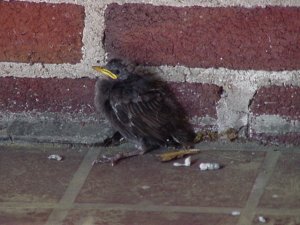Help - anyone who knows birds. Each year we have a starling mom build her nest on our front porch. I don''t remember how old the babies are as of date; but, they appear fairly large & w/ some feathers. This morning a commotion went on. I thought the babies were leaving the nest. Then, I saw another starling and some other birds gathering & chasing one another. After all that, I discovered a baby on the ground (porch).
I read conflicting reports on the wildlife spots. It''s definitely NOT a nestling. But, I am unsure that it is a "fledgling", which according to the net, should be left alone (doesn''t appear to be in any danger of animal attack). I''ve watched it most of the day. It tries to fly - but can''t quite get lift off. It can hop about - but not great. The mom has been swooping down. The baby opens it''s mouth. I don''t see any food going in; but, the mom is going through the motions of feeding it.
Question is - should I leave it alone (as suggested for fledglings - again I know nothing about it except what I''ve read on the net) or put it back in the nest? The nest is pretty crowded with two babies left (they are fairly large).
I want to really be well meaning - and not just "well meaning" & screw up the natural order of things.
I read conflicting reports on the wildlife spots. It''s definitely NOT a nestling. But, I am unsure that it is a "fledgling", which according to the net, should be left alone (doesn''t appear to be in any danger of animal attack). I''ve watched it most of the day. It tries to fly - but can''t quite get lift off. It can hop about - but not great. The mom has been swooping down. The baby opens it''s mouth. I don''t see any food going in; but, the mom is going through the motions of feeding it.
Question is - should I leave it alone (as suggested for fledglings - again I know nothing about it except what I''ve read on the net) or put it back in the nest? The nest is pretty crowded with two babies left (they are fairly large).
I want to really be well meaning - and not just "well meaning" & screw up the natural order of things.














300x240.png)